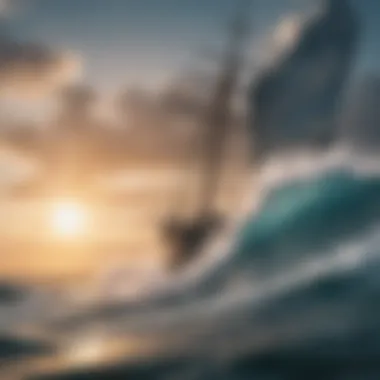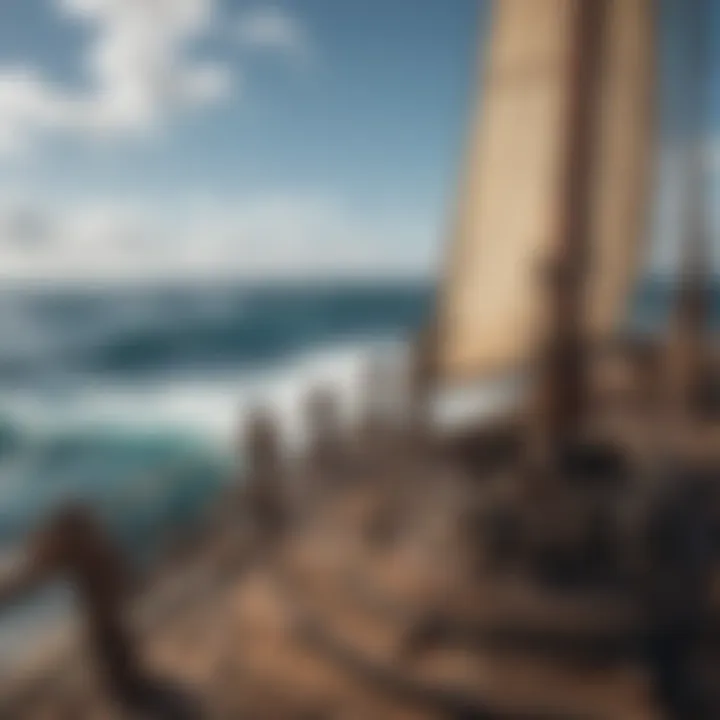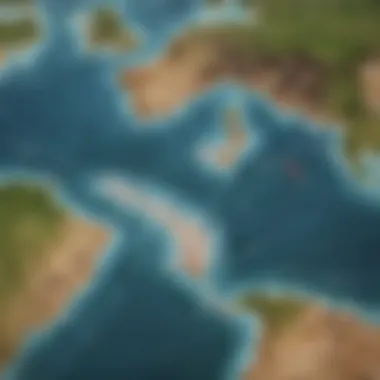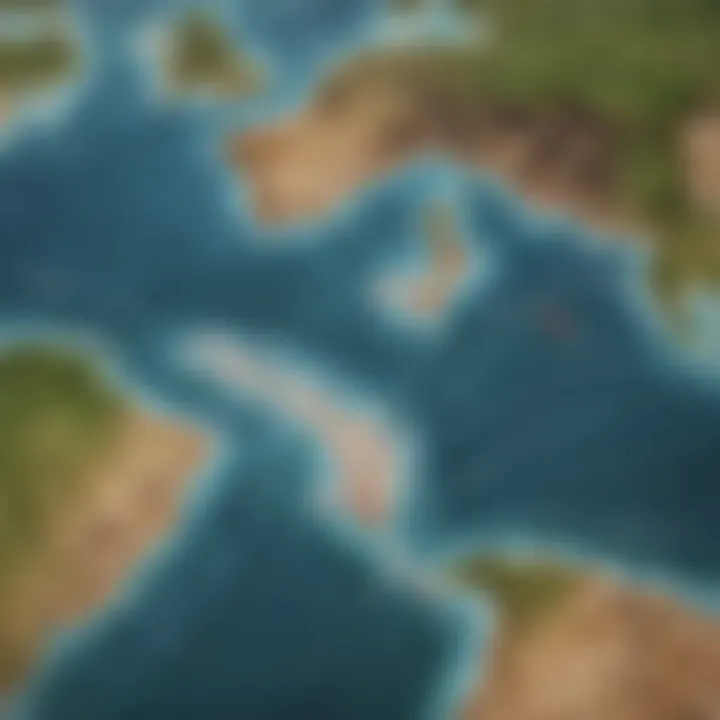Understanding Trade Winds: A Comprehensive Guide


Intro
Trade winds are more than just breezes that sway the palm trees; they are powerful atmospheric forces shaping the world's climates, maritime navigation, and even the trajectory of history itself. These steady wind patterns have been integral to exploration and trade since ancient times, guiding explorers across vast oceans and influencing weather systems that affect everyone.
Understanding trade winds entails delving into their origins, characteristics, and the essential role they play in our environment today. As we move forward, we will break down the mechanics of these winds, their mapping, and how they are vital to both amateur and professional water enthusiasts. Whether one is trying their hand at sailing or braving the open seas, grasping the nuances of trade winds can be the difference between a pleasant voyage and a perilous one.
This guide will not only explore the historical significance of trade winds but will also provide practical applications for modern sailors and explorers. By equipping oneself with this knowledge, you enhance the experience of engaging in water sports and navigating the intricacies of ocean travel.
Techniques and Skills
Mastering trade winds requires a combination of techniques and skills, especially for those venturing into water sports.
Essential Techniques for Beginners
For those just dipping their toes into the waters of sailing or kitesurfing, understanding trade winds starts with grasping the basics:
- Know the Prevailing Directions: Trade winds blow from east to west in the tropics. Identifying the dominant wind direction can help in planning routes and activities.
- Reading Local Conditions: Always observe how the trade winds behave in specific locations. They can change based on the time of day or geographic features.
- Adjusting Equipment: Learn to set up sails and kites that optimize for prevailing winds, enhancing speed and control.
Advanced Skills for Experienced Watersport Enthusiasts
For seasoned sailors and watersport veterans, honing skills takes precedence. Here are some strategies:
- Wind Shadow Navigation: Learn to recognize and navigate the shadowing effects created by landforms, which can alter wind patterns.
- Reading the Chocolate Sea: Experienced sailors often refer to water textures; learning to read these textures provides insights into wind speed and direction.
- Tuning Rigging for Performance: Adjusting and fine-tuning the rigging based on wind conditions can significantly improve efficiency and speed.
Equipment and Gear
Selecting the appropriate equipment and gear is essential when it comes to navigating the whims of trade winds.
Must-Have Gear for Each Watersport
Various watersports demand specific tools and items that cater to the wind conditions influenced by trade winds. Recommended gear includes:
- For Sailing: High-quality sails that respond well to varying wind degrees and rigging hardware that’s durable and resilient to ocean elements.
- For Kitesurfing: A versatile kite designed to operate effectively in both strong and light winds.
- For Stand-Up Paddleboarding: Lightweight boards that allow for easy handling when encountering wind shifts.
Tips for Selecting the Right Equipment
Picking the right tools can feel daunting, but several considerations can guide you:
- Research Reputable Brands: Some manufacturers are known for their durable and reliable products; brands like North Sails and Cabrinha are examples worth considering.
- Trial Before Purchase: If possible, try out equipment before committing. Many shops offer rentals to help gauge enjoyability and performance.
- Focus on Fit and Comfort: Especially for clothing and harnesses, ensure that they fit well to keep you comfortable regardless of the wind’s temperament.
Remember, understanding trade winds enriches not just your experience on the water, but contributes to the depths of environmental wisdom, guiding us towards sustainable practices in the oceans.
In the following sections, we will further dissect the mechanisms behind trade winds, delving into their mapping and how they can aid in maritime navigation.
Prologue to Trade Winds
Understanding trade winds is key for anyone with a passion for sailing, weather phenomena, or climate science. These winds, though often overlooked, play a significant role in shaping maritime navigation and influencing global weather patterns. For sailors and adventurers alike, comprehending the intricacies of trade winds can mean the difference between a smooth sail and a frustrating outing at sea.
Definition and Overview
Trade winds are persistent winds that blow from east to west in the tropics. They are a product of the Earth's rotation and the uneven heating of its surface by the sun. The most notable characteristic of these winds is their steady direction, which generally comes from the east—a key detail for navigators seeking to harness wind power effectively. Understanding this concept is fundamental for those participating in water sports, as it allows for strategic planning whether one is sailing, kiteboarding, or windsurfing.
"Trade winds are the lifeblood for mariners, keeping their sails full and their journey smooth."
These winds are an integral part of the Earth's climate system. Typically occurring between latitudes 30 degrees north and south of the equator, they originate from the subtropical high-pressure areas. The winds can vary in strength and direction based on seasonal changes, ocean currents, and geographical features.
Historical Context
The historical significance of trade winds cannot be understated. Sailors of yore relied on these winds to traverse vast oceans—enabling exploration and trade across continents. The Age of Sail was marked by daring adventurers who skillfully exploited these wind patterns.
For instance, during the 15th to 17th centuries, explorers like Christopher Columbus adeptly used trade winds during their transatlantic voyages. Columbus's expeditions were largely influenced by his understanding of these winds, which allowed him to make the most of favorable conditions and maintain progress toward his New World goals. Without the directional guidance of trade winds, modern concepts of global trade and exploration might look entirely different today.
In modern times, understanding the historical context of trade winds adds depth to our grasp of maritime practices and ecological impacts. As scientists and conductors of water-based sports, it’s crucial to recognize how much these winds have influenced human history—affecting not just navigation but also trade, cultural exchanges, and even migration patterns.


In summary, the story of trade winds is not merely a tale of meteorology; it is interwoven with human endeavor and progress across the ages, making their study essential for enthusiasts and professionals alike.
The Mechanics of Trade Winds
Understanding the mechanics of trade winds is crucial, as these atmospheric currents play an integral role in shaping our global weather systems and influencing maritime navigation. The trade winds hold their significance not only in weather patterns but also in the activities related to sailing and watersports. By dissecting the formation, the Coriolis effect, and seasonal variations of trade winds, we can glean valuable insights that aid both adventure seekers and seasoned navigators.
Formation of Trade Winds
Trade winds are primarily generated due to the unequal heating of the Earth's surface by the sun. This heating often leads to the development of high and low-pressure areas. Specifically, the trade winds originate from areas around the equator, where the sun's rays strike most directly. The warm air near the equator rises, leading to lower pressure at the surface. Cooler air from the subtropics, which is at a higher pressure, moves in to fill this void, creating a current.
Interestingly, the formation of trade winds isn't a simple north-south flow. They actually travel towards the equator from about the 30-degree latitude in both hemispheres, deflecting westward due to the Coriolis effect. This creates a consistent flow of wind that is instrumental for ocean currents and sailing routes.
"Trade winds are the backbone of global weather systems, securing a navigational path for seafarers over centuries."
Coriolis Effect
The Coriolis effect is another key element that adds complexity to the trade winds. As the Earth rotates, any motion above its surface—like the movement of air—is affected by this rotation. Wind flowing towards the equator is deflected westward in the Northern Hemisphere and eastward in the Southern Hemisphere. This curving motion is what creates the distinctive patterns of the trade winds.
Because of this effect, trade winds do not blow directly from high to low pressure; rather, they veer off at angles depending on the hemisphere. Sailors have long been aware of this phenomenon, as it can significantly influence a vessel's course. For those who navigate these waters, understanding the Coriolis effect can be the difference between smooth sailing and a wild ride.
Seasonal Variations
Just like how the mood can swing with the seasons, trade winds also exhibit variations throughout the year. Typically, these winds strengthen during the winter months and weaken during the summer. In the tropics, shifts in atmospheric pressure can lead to changes in wind patterns, impacting everything from weather conditions to ocean currents.
Such seasonal variations play a noteworthy role in forming tropical storms. As trade winds change, they can either suppress or fuel storm systems, making it essential for watersport enthusiasts to be observant of these patterns. In essence, failing to recognize these shifts can lead to unexpected challenges on the water.
By deepening our understanding of the mechanics of trade winds, we equip ourselves with knowledge that can markedly enhance our experiences and safety in water-based activities. Whether you're a sailor aiming for adventure or merely an enthusiastic observer, grasping these concepts can change how you interact with the wind and the waves.
Mapping Trade Winds
Mapping trade winds serves as a linchpin in our understanding of these vital wind systems. These routes are not mere lines on a chart; they are historical lifelines for sailors and explorers, leading them through vast oceans. Understanding how these winds have been charted enhances maritime navigation and informs modern activities like kiteboarding and sailing. Furthermore, it lays a foundation for discussions about climate patterns and weather forecasting.
Historical Maps and Their Importance
Navigational charts from centuries past are more than just artifacts; they offer us a window into the climatic conditions of their era. The reliance on trade winds for navigation was a crucial aspect that shaped global trade routes. For example, the famous explorers like Ferdinand Magellan and Christopher Columbus depended heavily on understanding these winds to reach their destinations across the Atlantic and Pacific Oceans.
The historical maps often depicted trade wind belts, such as the Northeast and Southeast Tradewinds, which played a critical role in defining ocean currents and weather patterns.
- Cultural Significance: These mappings connected distant worlds, facilitating the exchange of goods and ideas. The maps were pivotal in establishing maritime empires and influence.
- Practical Navigation: Sailors learned to rely on these winds for consistent travel times, turning them into a part of everyday navigation lore.
Thus, historical maps serve as invaluable references not just for their age but also for their ongoing relevance in maritime studies.
Modern Techniques for Mapping
Today's mapping techniques have undergone a seismic shift due to technological advancements. With tools like satellite imagery and Geographic Information Systems (GIS), our understanding of trade winds has become more nuanced and precise.
- Satellite Data: This provides real-time information about wind patterns, allowing sailors and meteorologists to employ data-driven strategies while navigating.
- Computer Modeling: Advanced models can simulate historical data to forecast changes in trade winds due to climate change.
Modern mapping techniques enable a higher degree of accuracy and predictive capabilities. They are essential for meaningful environmental assessments, allowing scientists and navigators to make informed decisions based on tangible data.
Interpreting Trade Wind Maps
Understanding how to read and interpret trade wind maps is crucial for anyone involved in nautical activities. These maps display not just the direction of winds but also their intensity, speed, and how these elements impact their surroundings.
"Effective navigation relies on understanding the currents created by trade winds, which can either buoy your journey or turn it into a tempest."
When reading these maps, one should consider:
- Wind Zones: Familiarity with different wind zones helps in planning routes that optimize sailing or kitesurfing experiences.
- Seasonal Patterns: Knowing how wind patterns shift with seasons is key for both casual and competitive watersport enthusiasts.
- Technological Integration: New apps and devices provide real-time updates, making it easier to visualize current wind conditions.
Understanding these elements not only aids in navigation but enriches the overall experience of those seeking adventure on the water.
Trade Winds and Climate


Understanding the interplay between trade winds and climate is vital for grasping how these vast air currents shape weather patterns across the globe. Trade winds, with their persistent nature, do not just affect maritime navigation but also have significant implications for climate dynamics. Their influence on oceanic temperatures and atmospheric pressure systems makes them key players in the broader climate narrative.
Influence on Global Weather Patterns
Trade winds are integral to maintaining the planet's climatic balance. These winds blow from east to west across the tropics and are strongest near the equator. Their role in creating the major ocean currents is fundamental; for instance, the North Equatorial Current and the South Equatorial Current primarily flow due to the trade winds. This circulation of ocean water directly contributes to temperature regulation across different regions.
Here are a few crucial aspects of their influence:
- Temperature Moderation: By moving warm water from the equator towards the poles, trade winds help in distributing heat, thus moderating coastal temperatures.
- Precipitation Patterns: The interaction of trade winds with the Earth's geography often leads to the formation of rain belts. Areas influenced by these winds, like the Caribbean and parts of Southeast Asia, experience distinct wet and dry seasons.
- Cyclones and El Niño: When trade winds weaken or shift, consequences can be dramatic, leading to phenomena such as El Niño, which creates altered weather patterns globally, including droughts in some areas and excessive rainfall in others.
"Without the trade winds, our world would be a vastly different place, impacting everything from flora and fauna to human habitation strategies.”
This highlights the pivotal position trade winds occupy in the delicate balance of Earth’s weather system.
Impact on Tropical Storm Development
The relationship between trade winds and tropical storms is another critical aspect of climate dynamics. When conditions align, trade winds can either aid in storm formation or inhibit it.
- Storm Formation: Warm ocean waters are essential for the development of tropical storms. Trade winds can contribute to rising warm, moist air which fuels these storms. When winds converge at the surface and rise, it can create a low-pressure system conducive to tropical cyclone formation.
- Storm Trajectories: The strength and direction of trade winds can steer tropical storms. For example, during an active hurricane season, strong trade winds may push storms away from the coast or toward land, drastically altering their impact.
- Wind Shear: Conversely, strengthening trade winds can lead to increased wind shear, which may act as a barrier to storm development. High wind shear can disrupt the organized structure of storms, reducing their intensity.
To summarize, trade winds are not merely a backdrop but a dynamic force that influences weather patterns and storm behaviors profoundly. Understanding their role is crucial, especially for sport enthusiasts and navigators who rely on accurate weather predictions for their activities. With changing climate conditions, the future dynamics of trade winds and their broader climate impact is an area ripe for further exploration and study.
The Role of Trade Winds in Navigation
Navigating the expansive blue has always been a dance with wind, waves, and time. Trade winds play a pivotal role in this traditional art, offering sailors both guidance and challenge. Understanding their behaviors is not just useful; it’s essential for anyone wanting to traverse the seas effectively. Without the wind in your sails, you might as well be a fish trying to climb a tree.
The predictable patterns of trade winds, blowing from east to west in tropical regions, were the sailors’ compass long before modern navigation tools came into play. This natural phenomenon has been harnessed for centuries, allowing explorers and traders to cross vast oceanic expanses with some degree of certainty. It’s a kind of nature’s highway where understanding the wind patterns can mean the difference between success and calamity.
Historical Navigation Techniques
Long before GPS and satellite maps, mariners relied heavily on their understanding of the trade winds. Ancient navigators mapped these winds as accurately as they charted their course. They developed various innovative techniques to sail in sync with these constant breezes.
- Celestial Navigation: Sailors would gauge their position by observing celestial bodies, aligning their sails with trade winds to ensure they stayed on course.
- Use of the Compass: The magnetic compass became a trusty companion. It aided sailors in aligning their direction with the prevailing winds.
- Wind Maps: These early maps illustrated the trade wind bands, marking them as vital areas for safe travel.
- Local Knowledge: Ancient peoples, from Polynesian navigators to Mediterranean seafarers, passed on knowledge of specific wind behaviors and seasonal shifts. This oral tradition carried wisdom on when to sail and when to stay put.
The knowledge of trade winds was as sacred as the stars for those who sailed. Without it, exploration might have remained a mere fantasy.
In historical contexts, relying on trade winds meant less chance of drifting aimlessly. It meant fewer rounds of guessing where land lay beyond the horizon. Mariners understood that the way to harness these winds was through timing and strategy.
Modern Sailing Strategies
Fast forward to today, and while technology has redefined navigation, trade winds remain a relevant player in the marine world. For modern sailors, understanding these winds can enhance their experiences and performance on the water.
- Sail Planning: Skippers often study forecasted wind patterns, choosing their sailing times based on expected shifts. Trade winds can become more predictable during certain seasons, allowing sailors to optimize their routes.
- Sailing Vessels Design: Many sailboats today are engineered to take full advantage of trade winds, sporting sails and hulls suited for these specific conditions. A well-designed boat can leverage the wind better, responding actively to changes.
- Weather Technology: Modern tools such as satellite weather systems provide real-time data, allowing sailors to make informed decisions based on current wind conditions and forecast accuracy.
- Regatta Tactics: In competitive sailing, understanding trade winds can lead to winning outcomes. Sailors take calculated risks, making split-second decisions based on shifts in wind patterns during races.
Navigators who grasp how to work in harmony with trade winds tend to sail with increased confidence. They don’t just rely on machines; they also pay heed to the ancient dance between wind and sea. Being attuned to the trade wind's rhythm turns the nautical journey from a mere commute into a symphony of skills and time-honored knowledge.
Practical Applications for Watersport Enthusiasts
When it comes to watersport activities, understanding trade winds is not just a nice-to-have, but rather an essential component for enthusiasts looking to optimize their experiences. Whether sailing, kiteboarding, or windsurfing, these winds play an invaluable role in shaping the conditions of the ocean and, by extension, the enjoyment and safety of these activities.
Trade winds primarily blow from east to west near the equator, and their consistent nature allows for predictable weather patterns. This predictability translates into significant advantages for watersport participants. Familiarity with trade winds can help enthusiasts plan their outings, maximize their time on the water, and ultimately improve their performance.
Sailing Techniques Adjusted for Trade Winds
Sailing in trade winds requires a specific set of techniques that differ from those used in variable conditions. Sailors should keep in mind that:
- Trim the sails properly: To harness the full power of the trade winds, the sails should be adjusted to capture the wind efficiently. A tighter sail can help in gaining speed without compromising control.
- Course selection: Understanding the wind’s direction will allow sailors to chart a course that minimizes resistance. Close-hauled or beam reaches usually optimize speed and sail performance in trade winds.
- Heaving to: In stronger winds, knowing how to heave to can hold the boat steady. This technique can give sailors a breather when conditions get too intense.
Familiarizing oneself with the behavior of trade winds at different times of the day can also provide insights into optimal sailing times—often, winds tend to be steadier in the afternoon.
Kiteboarding and Windsurfing in Trade Winds
Kiteboarding and windsurfing enthusiasts thrive in consistent wind conditions and trade winds deliver just that. Here are some core considerations for both activities:


- Equipment choice: Kiteboarders should invest in kites that are specifically designed for higher wind ranges. Likewise, windsurfers should utilize boards and sails tailored to handle the robust wind forces typical in these conditions.
- Launch and landing techniques: Proper techniques for launching and landing kites in stronger winds can make or break a session. Enthusiasts should practice these maneuvers to avoid accidents.
- Spot selection: Choosing the right location is key. Areas with a clear downwind space and minimal obstacles will make for an ideal environment to ride the trade winds without the worry of crashing into anything.
Understanding trade winds can enrich the experiences of watersport enthusiasts by enhancing their safety, boosting performance, and ultimately providing the thrill that these sports are known for. Not only does this knowledge allow for more enjoyable outings, but it also fosters a deeper connection to the environment, as enthusiasts learn to respect and work with nature.
"Knowledge of trade winds offers watersport enthusiasts not just an edge—it's a pathway to deeper enjoyment and understanding of their sport."
By engaging with the characteristics of these winds, watersport lovers can truly maximize every moment spent on the water.
Environmental Considerations
Understanding environmental aspects related to trade winds is pivotal, especially in today’s context where climate change is the elephant in the room. Trade winds play a crucial role in shaping our planets' climate, impacting both local and global weather patterns. Their interactions with ocean currents, ecosystems, and atmospheric conditions create an intricate ballet that deserves closer inspection. Knowledge in this area is not merely academic; it equips watersport enthusiasts, navigators, and environmental advocates with the tools needed to respond to the ever-shifting tides of our climate crisis.
Trade Winds and Climate Change
Trade winds, while seemingly a natural phenomenon that seizes our attention, also carry significant implications regarding climate change. As these winds shift and change in strength, they influence ocean temperatures and, consequently, global weather patterns. For instance, a weakening in the trade winds tends to contribute to warmer water in the central Pacific, leading to unusual weather events like El Niño. This not only disrupts marine ecosystems but also affects agricultural practices worldwide.
Furthermore, understanding the feedback loops between trade winds and climate change can help scientists predict future scenarios. For example, as trade winds weaken, the likelihood of extreme weather events can increase, affecting everything from sea levels to rainfall distribution. It’s an interactive dance you could say—where changes in one element prompt adjustments in another, sometimes with alarming consequences.
"Understanding trade winds' behavior is like holding a map to the future of our planet's climate system."
Sustainability in Watersports
The pursuit of watersports is exquisite, yet it is crucial to balance excitement with sustainability. Trade winds can either impede or enhance the experience of sailors, kiteboarders, and surfers, but they can also reflect the changing state of our environment. As watersport enthusiasts become aware of the impacts of climate change on trade winds, they can employ sustainable practices to mitigate these effects. This includes being mindful of carbon footprints, respecting marine habitats, and adopting eco-friendly materials in gear and equipment.
Here are some strategies for sustainable watersports:
- Choose Eco-Friendly Equipment: Opt for boards and sails made from sustainable materials to lessen environmental impact.
- Practice Leave No Trace Principles: Always clean up after yourself, ensuring the natural beauty of coastlines remains pristine for future adventurers.
- Get Involved in Local Conservation: Participate in or support local cleanup efforts and conservation initiatives to protect marine life.
- Educate and Spread Awareness: Share insights about the significance of understanding trade winds with fellow enthusiasts. Knowledge can galvanize action.
Navigating the delicate balance between enjoying the wind and respecting it is crucial. When watersport practitioners adopt sustainable practices, not only do they enjoy but also preserve the ecosystems that make their beloved activities possible. Hence, blending enthusiasm with responsibility forms a fundamental pillar in the way forward.
Future Research and Developments
Understanding the intricate systems of trade winds is not just a matter of academic interest but poses significant implications for various fields, including meteorology, navigation, and even environmental science. As we face changing climates that could potentially alter wind patterns, the need for thorough research in this area has never been more pressing. By examining future research and developments regarding trade winds, we can grasp their ever-evolving nature and importance.
Innovations in Weather Forecasting
In the realm of meteorology, innovations in weather forecasting are paramount, especially when it comes to predicting the behavior of trade winds. Advanced computer models and satellite technology have broadened our ability to analyze wind fluctuations over vast distances. Interestingly, these advancements are not just tech wizardry; they play a crucial role in anticipating severe weather events and ensuring safety on the seas.
Recent developments, for instance, have shown that enhanced machine learning algorithms can interpret complex data from various sources with greater precision. These innovations allow meteorologists to create more accurate and timely forecasts, which are essential for everyone from fishermen to shipping companies. Being able to pinpoint the shifts in trade winds can significantly reduce risks and improve planning for marine excursions.
Moreover, predictive techniques are showing promise in identifying potential economic impacts tied to changes in wind patterns. If trade winds strengthen or weaken, it can affect global shipping routes and trade timelines. Thus, understanding these currents offers critical insights into economic planning and logistics.
Ongoing Studies on Trade Winds
Ongoing studies focused on trade winds are shedding light on a multitude of factors that affect their dynamics. This research not only furthers our understanding but also prompts significant inquiry into their impact on global weather patterns and climate behavior.
Researchers are increasingly investigating the correlation between trade winds and climate change. As global temperatures continue to rise, subtle shifts in these persistent winds can lead to altered precipitation patterns and temperature distributions around the globe. This is particularly crucial for regions that are heavily reliant on agricultural outputs influenced by weather patterns.
Additionally, field studies involving direct measurement of wind speeds and directions are being conducted across different geographical locations. These hands-on investigations reveal real-time data that help in refining existing models of trade winds, making them more reliable.
"Studying trade winds today can help us explain not only the weather of tomorrow but also the climate we’ll face in the future."
Furthermore, the interplay between local geographical features and trade winds is another area of exploration. For instance, the impact of mountains or urbanizations on wind patterns can provide valuable information for urban planners and environmentalists alike.
Culmination
Understanding trade winds is not just a matter of academic curiosity; it's crucial for anyone involved in maritime activities. The dynamics of these winds are complex yet fundamental to many aspects of navigation, climate, and environmental awareness. By grasping how trade winds behave, sailors, kiteboarders, and windsurfers can optimize their performance. They can adjust their strategies with the wind at their backs, enhancing both safety and efficiency.
The Significance of Understanding Trade Winds
Understanding trade winds carries significant implications on various fronts. For instance, knowing the seasonal patterns of these winds helps sailors to plan voyages with precision; they can anticipate when to set sail and when to avoid treacherous conditions. This foresight translates into more enjoyable and successful sailing experiences.
Moreover, trade winds also influence weather systems. Meteorologists and climate scientists study these winds to better predict weather patterns and shifts in climate. This is particularly important in an era where climate change impacts are becoming increasingly visible.
Trade winds play a crucial role in the development of tropical storms. As they interact with warm ocean currents, they can either exacerbate or mitigate storm intensity. For those in watersports, understanding these nuances can mean the difference between a thrilling day out and one spent onshore.
"Knowledge of trade winds is a sailor's best friend—it's like having an insider’s knowledge of a hidden path through the clouds."
Finally, the environmental implications are vast. As we become more attuned to sustainable practices, recognizing how trade winds affect ocean currents contributes to a greater understanding of marine ecosystems. Thus, embracing knowledge of trade winds leads to informed decisions in both leisure and profession.
In summary, comprehending trade winds is indispensable for mariners and environmental stewards alike. With this guide, readers have the tools to leverage trade winds to enhance their adventures on the water while being responsible stewards of the environment.







